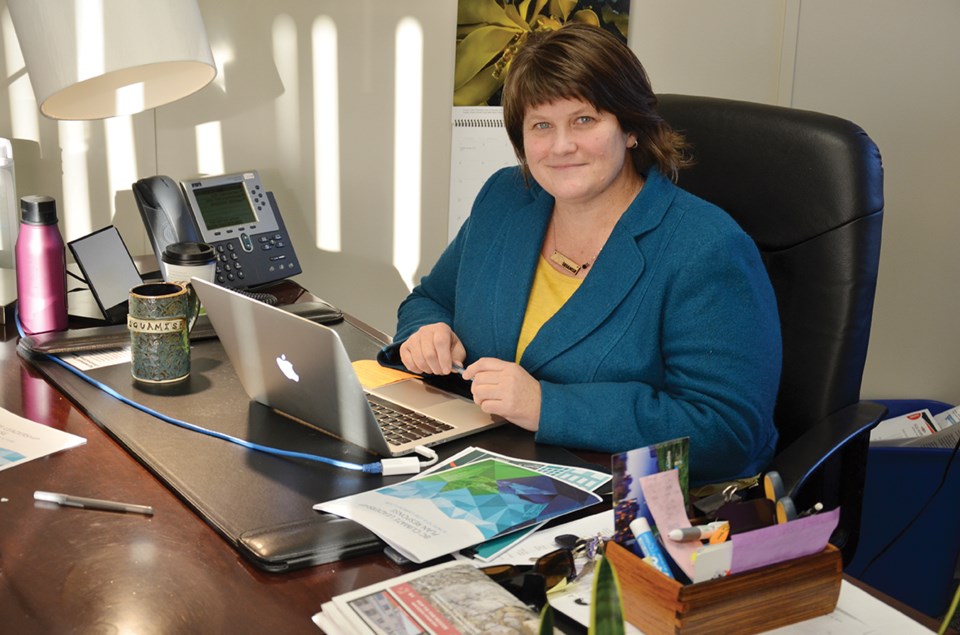With a cluster of three bicycles in the corner of the room and a towering BMX trophy behind the desk, there’s no mistaking this for any other mayor’s office than one in Squamish.
And it’s the small, personal touches – Squamish artist Toby Jaxon’s paintings hanging on the wall, the LED lights, a ukulele on a coffee table and the organic waste bin tucked beside the desk – that give insights into the person who took over the seat a year ago.
“I don’t think I am saying anything different than I did 10 years ago, but people listen now,” says Squamish Mayor Patricia Heintzman.
When the long-time Squamish resident took over the municipal helm in December 2014 from then-mayor Rob Kirkham, she was already a seasoned politician. Heintzman was first elected to council in 2005. But there’s a difference between being at the table and at its head, Heintzman says, as she reflects about her first year wearing the chain of office.
“It’s a different role working as a mayor because you really try to marry everyone’s expectations and make sure everyone is heard,” she says. “I have had my hiccups on that front. I am definitely learning on the go.”
It’s been a busy year, Heintzman acknowledges. Since she took office, Heintzman can count the weekends she has had off with one hand.
The Squamish Oceanfront deal that sets out to transform the former industrial site at Nexen Beach into a third employment lands, a third residential area and a third park should finally wrap up no later than early in the new year, she says.
“It’s been a long time coming,” Heintzman says, noting some 10 years ago she was on the original board tasked with the lands.
While this council is dealing with the tailings of the former council, they’re also forging ahead with policies that lead the municipality in a new holistic direction, she says. Having set a goal to become carbon neutral in the coming year, the district is examining ways to implant the newly printed B.C. Climate Leadership Plan into procedures and a sustainable economic future.
The municipality is working to position itself as a global innovation hub where groups of educators, innovators and entrepreneurs can collaborate on tangible climate change solutions, Heintzman says. That idea has already taken shape at the oceanfront, with the opening of operations of a carbon capturing company, Carbon Engineering, last summer.
“This work will extend into 2016,” she says regarding laying the foundations for an environmentally respectful and economically sustainable future.
The mayor is also looking into how the municipality will be able to buy carbon offsets in the province’s push to have government bodies carbon neutral and be assured that the money will be returned to local projects. Ultimately, Heintzman sees a future in which Squamish companies and individuals will be able to do the same.
“We are really making a commitment. We are taking it seriously and we are really seeing us [the municipality] as being a part of the global solution,” she says of the district’s climate action goals.
A tangible change between the previous council and that of 2015 is the municipality’s strengthening relationship with the Squamish Nation, Heintzman says. The district is looking for synergies between the communities, as staff attend policy workshops together. Heintzman also hopes to see more staff exchanges in the future and pooling of resources.
“I meet the Squamish Nation monthly,” she says. “We are really finding meaningful ways of being true community partners.”
In 2015, the district made a dive into the digital era. The municipality received an award of excellence for its geographic information system (GIS) software. Heintzman anticipates residents will see more “opening up” of municipal data systems in the future, as well as mobile applications.
“We are being constantly mindful of the importance of meaningful community engagement,” she says.
In the year ahead, Heintzman sees managing the major influx of development as a priority and challenge. In 2015, development applications rose by more than 50 per cent.
“We’ve got a lot of work there still to do because we are playing catch-up,” she notes.
The number of business licenses issued by the district has risen by more than 20 per cent this year. Without revealing details, Heintzman also hints at there being “some stuff on the Oceanfront that is percolating.” Squamish is drawing interest from a whole new group of developers and employment opportunities, she says.
With a buzz around Squamish and a ramping up of rapid development, the community has felt its share of growing pains.
“We were hit very quickly with affordable housing issues this year,” she says, adding the district is tweaking bylaws to allow for the building of smaller homes and diversity in housing options.
In Heintzman’s mind, all of these changes aren’t taking place fast enough; she jokes she has the patience of a two-year-old. While she feels the district is on the right track, there’s much legwork to be completed, Heintzman says, before her goals will become a reality.
“I have frustration with the pace of change within a bureaucracy,” Heintzman acknowledges. “I can see the outcomes in my mind but often there’s a lot of groundwork to get there.”
To reach them, the community as a whole has to come together. People need to start looking at the government in a different way, Heintzman says.
“We can’t do it all,” she says. “But we can create the foundations and the right soil conditions for everyone else to prosper.”



